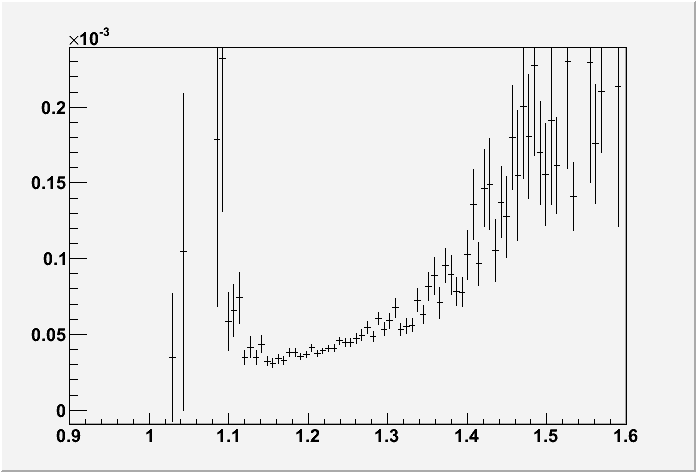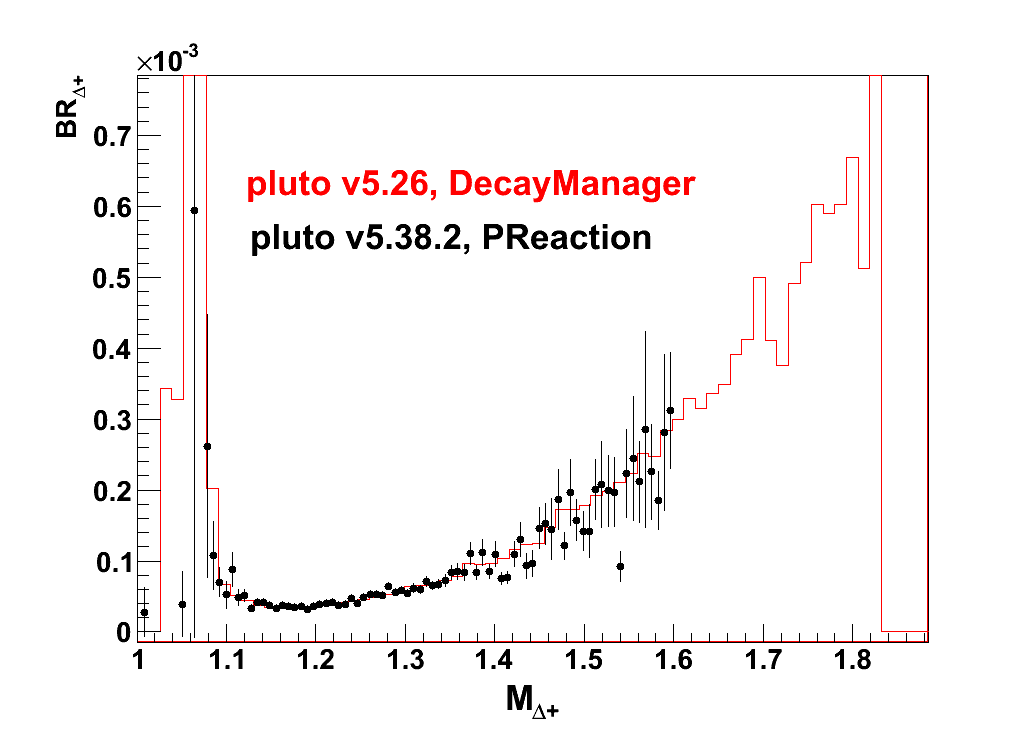Home » Hades » Pluto » [CLOSED] Delta from Krivoruchenko
| [CLOSED] Delta from Krivoruchenko [message #12703] |
Fri, 07 October 2011 10:47  |
 Ingo Froehlich
Ingo Froehlich
Messages: 167
Registered: March 2004
Location: IKF - Frankfurt
|
first-grade participant |
From: *dip.t-dialin.net
|
|
Dear all,
please update to v5.38.2. In the previous version, the Krivoruchenko model was not enabled by using the following command:
makeDistributionManager()->Exec("dalitz_mod: krivoruchenko");
It is very important to check the output of the reaction, it should print:
[D+_krivoruchenko] dgdm from Krivoruchenko {/}
some more word to the calculation of branching ratios. By default, Pluto does not calculate the branching ratio, but takes as a weight 1/N_ev * BR, where BR is the static branching ratio. This leads of course to incorrect results at the pole, if the branching ratio shows a large mass-dependency.
The only way to let Pluto calculate the branching ratio, is the "Monte-Carlo-Integration method". In this case one has to use a flat dilepton mass generator:
makeDistributionManager()->Exec("dalitz_mod: static_br_thresh=0.100 ; flat_generator");
By using this, the another model is added:
[D+_generator_p_dilepton] Dilepton generator {/generator}
I attached below a macro which uses this method.
Toggle Spoiler
makeDistributionManager()->Exec("elementary");
makeDistributionManager()->Exec("dalitz_mod: krivoruchenko");
makeDistributionManager()->Exec("dalitz_mod: static_br_thresh=0.100 ; flat_generator");
PReaction *my_reaction =
new PReaction("3.5","p","p","p D+",NULL,1,0,0,0);
TH1F * pp_sum =
new TH1F ("pp_sum","pp DiLepton mass (coherent sum)",100,0.,0.6);
pp_sum->Sumw2();
TH1F * delta =
new TH1F ("delta","D mass ",100,0.9,1.6);
delta->Sumw2();
my_reaction->Do(pp_sum,"_x=[dilepton]->M()");
my_reaction->Do(delta,"_x=[D+]->M()");
my_reaction->Print();
my_reaction->Preheating(100);
my_reaction->Loop(100000);
PReaction *my_reaction2 =
new PReaction("3.5","p","p","p D+ [dilepton p]",NULL,1,0,0,0);
TH1F * pp_sum2 =
new TH1F ("pp_sum2","pp DiLepton mass (coherent sum)",100,0.,0.6);
pp_sum2->Sumw2();
TH1F * delta2 =
new TH1F ("delta2","D mass ",100,0.9,1.6);
delta2->Sumw2();
my_reaction2->Do(pp_sum2,"_x=[dilepton]->M()");
my_reaction2->Do(delta2,"_x=[D+]->M()");
my_reaction2->Print();
my_reaction2->Preheating(100);
my_reaction2->Loop(100000);
// delta2->Divide(delta);
delta->Draw("");
delta2->Draw("same");[/QUOTE]
The result is shown below:

and this is the branching ratio which I obtain:

-
 Attachment: kriv.png
Attachment: kriv.png
(Size: 10.79KB, Downloaded 1232 times)
-
 Attachment: c1.png
Attachment: c1.png
(Size: 6.24KB, Downloaded 1277 times)
--
Ingo Froehlich
IKF - University of Frankfurt
069-798-47027, FAX: -47024
[Updated on: Wed, 22 May 2013 12:37] Report message to a moderator |
|
|
|
|
|
| Re: Delta from Krivoruchenko [message #12711 is a reply to message #12708] |
Tue, 11 October 2011 18:28   |
 Ingo Froehlich
Ingo Froehlich
Messages: 167
Registered: March 2004
Location: IKF - Frankfurt
|
first-grade participant |
From: *dip.t-dialin.net
|
|
Dear Adrian,
thank you for this observation. I understand now much clearer what you mean when talking about fluctuations.
I think they source of the fluctuation is as follows: the pure Delta does not have the large tails. When you use the intrinsic calculation of the branching ratio (this is what we do when you want to have the correct b.r. at pole), I have to disable the explicit mass-dependent partial decay width, i.e. the tail at large masses is also disabled.
This means we strongly enhance the remaining tails. You can see this also in my plot, where I have plotted the mass-dependent branching ratio. So it is not a matter of statistics.
The only way to avoid this is to go back to the "classical" method (no flat di-electron generator). But in this case, as you know, the weight is fixed to 1/N_ev * "static branching ratio". This means you have to correct the old histogram such that it overlays with the new one, than you have a correction factor.
If I think more about it, there could be one solution, this is a "box-like" Delta generator together with the weight of the shape. But I never tested this and it is one additional source of complication.
--
Ingo Froehlich
IKF - University of Frankfurt
069-798-47027, FAX: -47024
|
|
|
|
|
|
| Re: Delta from Krivoruchenko [message #12726 is a reply to message #12712] |
Wed, 19 October 2011 10:54   |
 Piotr Salabura
Piotr Salabura
Messages: 220
Registered: June 2004
Location: Institute of Physics Jagi...
|
first-grade participant |
From: *if.uj.edu.pl
|
|
Here I post document written by Beatrice which summarize differences in descriptions of Delta Dalitz decays by various models which exist on the market. In _Pluto we use Krivoruchenko/Martemayenov which is eq. to Zetenyi/Wolf (if use constant form-factors)
Piotr
Salabura Piotr
Institute of Physics
Jagiellonian University
salabura@if.uj.edu.pl
|
|
|
|
| Re: Delta from Krivoruchenko [message #12738 is a reply to message #12703] |
Thu, 20 October 2011 09:17   |
 Malgorzata Gumberidze
Malgorzata Gumberidze
Messages: 99
Registered: June 2005
|
continuous participant |
From: *gsi.de
|
|
I have made similar studies for the pp@2.2.
For the pluto cocktail which is included into the
draft of the publication we were using pluto version v5.36
and PDecayManager. In the plot below you can see mass
dependent branching ratio for the Delta+ in channel
pp->pD+.
the color meaning is following:
Pluto v5_36 with DecayManager, not working Krivoruchenko, no flat generator
PLEASE notice that there is mistake in the label in plot, it is v5.36 and not v5.26
Pluto v5_38.2 with PReaction and all flags switch on:
makeDistributionManager()->Exec("elementary");
makeDistributionManager()->Exec("dalitz_mod: krivoruchenko");
makeDistributionManager()->Exec("dalitz_mod:static_br_thresh=0.100 ; flat_generator");
In case of the BLACK normalization comes for free using weights. RED curve is normalize in a way that at pole this ration is 4.15e-5.

mass dependance of the BR in both calculations are very similar.
That means if the DecayManager spectra are scaled such that average BR is 5.9e-5 (as obtain with the recommnded procedure from the Forum) then the resulting Delta contribution to the dilepton mass spectrum should be fine.
same investigation for the rho0 will follow
gosia
[Updated on: Thu, 20 October 2011 10:29] Report message to a moderator |
|
|
|
|
|
|
|
|
|
| |
  |
Goto Forum:
Current Time: Thu Jul 03 04:26:40 CEST 2025
Total time taken to generate the page: 0.00751 seconds
|
 GSI Forum
GSI Forum